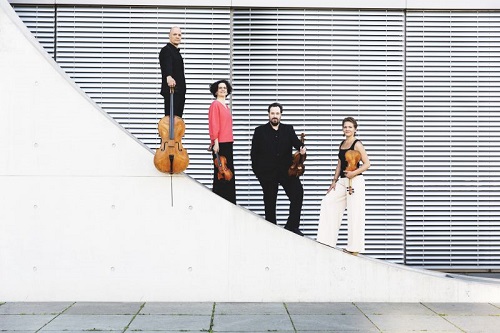 United Kingdom Mozart, Bartók, Mendelssohn: Artemis Quartet (Vineta Sareika & Anthea Kreston [violins], Gregor Sigi [viola], Eckart Runge [cello]), Wigmore Hall, London, 14.2.2018. (CS)
United Kingdom Mozart, Bartók, Mendelssohn: Artemis Quartet (Vineta Sareika & Anthea Kreston [violins], Gregor Sigi [viola], Eckart Runge [cello]), Wigmore Hall, London, 14.2.2018. (CS)

Mozart – String Quartet in F major K590, ‘Prussian’
Bartók – String Quartet No.2 BB75
Mendelssohn – String Quartet No.3 in D major Op.44 No.1
When the Artemis Quartet put bow to string at this Cavatina Trust-supported recital at Wigmore Hall, I was immediately struck by the Quartet’s balancing of unanimity and individuality. The intonation in the unison flourish which marked the opening of the concert was flawless; the articulation cohered perfectly. But, as Mozart’s Quartet in F K590 unfolded, the four players conveyed their own personalities through their respective manner of performance and seemed to relish their independence as performers as much as their involvement in an ensemble conversation.
Leader Vineta Sareika’s playing is quite muscular and taut, the tone lean but sweet; Anthea Kreston produces a more expansive, earnest sound and her second violin lines formed a warm inner texture with Gregor Sigl’s viola, the latter rising to the fore with strong projection and rich colour. Cellist Eckart Runge balances Sareika’s tautness, his strong sound provided sure but buoyant foundations for the discourse above. Visually, too, they communicated their independence, choice of concert dress ranging from modern suit to tunic and leggings, with Sigl looking as if he had stepped from the pages of a Tolstoy novel!
The independent voices form an exciting mix: each is an equal in the musical debates, and each made its mark in the vigorous conversations. But, sustaining and controlling such intensity and insistence is a challenge, and the Allegro moderato of the Mozart Quartet took a little while to find its equilibrium – for the concertante textures and quite prominent ‘soloistic’ passages to settle into a firm groove. The exposition felt quite ‘wry’ and light-hearted but the mood darkened and deepened as the syncopation and imitative scales of the development propelled the movement onwards. The tone at the start of the following Allegretto was quite grainy but Sareika freed herself from the lower parts and took off in graceful flight, and as she coaxed the other voices to join her the texture remained lucid, highlighting some abrupt contrasts. And, surprise and contrast underpinned the Menuetto which seemed to twist and turn in unexpected directions, Runge’s oscillating ‘wobble’ at the close threatening to destabilise things further before the robust cadence quelled the insurgency. The final Allegro was lithe and witty, as Sareika slithered breezily through the running semiquavers before the Quartet deftly put the brakes at Mozart’s wry fermatas. The movement is complex and there was considerable drama and variety, but light-spiritedness won out in the end.
Mendelssohn’s D Major Quartet Op.44 No.1 was similarly exuberant and full of joy. Except for Runge, who was seated on a raised platform, the players perform standing and this gave them freedom and inspired vitality. The Artemis Quartet attacked the Molto Allegro vivace with fervour, Sareika’s arpeggio flourish landing on a scintillating bed of sound. And, the Quartet took Mendelssohn at his word: the tempo was very fast and the mood exhilarating. But, the second subject felt a little rushed: there certainly is a quiet urgency as the homophonic theme nudges forward, but here it felt breathless and lacking in the spaciousness which would allow the viola’s trembling inner line to speak more tellingly. The Menuetto had greater gentility and warmth, and the fluently flowing quavers of the minor-key trio – whispered with delicacy – maintained the spirit of the dance. However, again I found the Andante too hasty, and the individual voices and ideas too ‘competitive’ and overly rhetorical. Yes, Mendelssohn does instruct ‘con moto’, but also, ‘espressivo’ and I’d have liked Kreston to have had more time and space to allow the second violin’s beautiful inner line to truly sing, and for the whole Quartet to have emphasised the Mendelssohnian sweetness of the movement. The finale, Presto con brio, was impressive though – well-tuned, fleet, volatile, even explosive at times.
It was in Bartók’s Second Quartet, however, that the Artemis seemed really at home. They communicated an innate appreciation of the structure of the whole quartet. And, in this work the equality of the players’ voices, and their contrasting tone qualities, were perfectly attuned to Bartók’s creative thoughts and methods, as the individual instruments seem to reflect on the shared material in their own way, following their own trains of thought. They captured the essence of the musical conversation – all its conflicts, excesses, compromises, conciliations and ultimate cohesion. In the Moderato they created a rich sound-world which conveyed dark, sometimes troubled, passions, Runge’s firm, wiry cello line providing a strong support for Sareika’s high sheen, and the middle voices speaking assertively. The folky tint of this opening movement blossomed into resonant, vibrant dances in the Allegro molto capriccio: precision and bite were the order of the day as the dances organically unfolded, and the dialogues were at times almost violent in their intensity. Finally, the Artemis Quartet relished the rare extensive melodism of the long, slow finale, skilfully shaping the lament towards its sorrowful close.
Claire Seymour